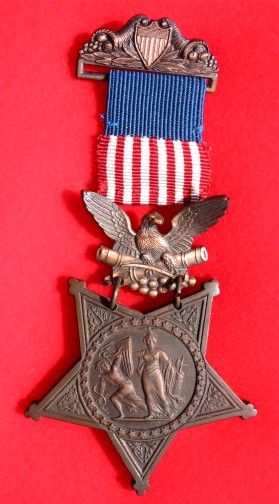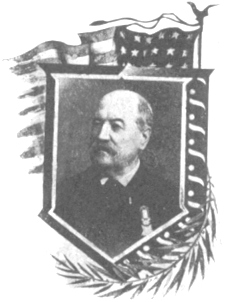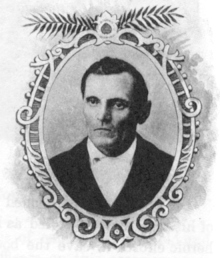
CONGRESSIONAL MEDALS OF HONOR - 12th WVI

The Medal of Honor
Civil War Era Design
[Photo by David Aeberli; owned by Linda Fluharty.]
The U. S. Army Congressional Medal of Honor for distinguished service was approved by Resolution of Congress No. 43 on 12 July 1862. Initially reserved to enlisted men, this restriction was retroactively amended to include officers by Section 6 of the U. S. Congress on 3 March 1863. The Army medal differs from the Navy in its suspension from a spread eagle atop two crossed cannon and eight cannon balls. Two thousand medals were ordered to be struck in 1862 and 470 recipients during the Civil War are listed in the Official Records. The majority of the U. S. Army Congressional medals were awarded many years after the Civil War through recommendations of a former commander, by application of the soldier, or his family. The greatest percentage of a U. S. Army Congressional Medals of Honor were awarded in the 1890s and these recipients do not appear in the Official Records. The Medal of Honor of the United States Army published in 1948 by the Public Information Division of the Department of the Army includes a complete listing of Congressional Medals of Honor.
APPLE, ANDREW O.
Rank and organization: Corporal, Company I, 12th West Virginia Infantry. Place and date: At Petersburg, Va., 2 April 1865. Entered service at: ------. Birth: Northampton, Pa. Date of issue: 12 May 1865. Citation: Conspicuous gallantry as color bearer in the assault on Fort Gregg. Corporal A. O. Allen was among the officers and enlisted men selected on 27 April 1865 to accompany the major-general commanding the corps to Washington to witness the presentation to the War Department of the colors surrendered by Lee's Army.
CURTIS, JOSIAH M.
Rank and organization: Second Lieutenant, Company I, 12th West Virginia Infantry. Place and date: At Petersburg, Va., 2 April 1865. Entered service at: Ohio County, W. Va. Birth: Ohio County, W. Va. Date of issue: 12 May 1865. Citation: Seized the colors of his regiment after 2 color bearers had fallen, bore them gallantly, and was among the first to gain a foothold, with his flag, inside the enemy's works.
DURHAM, JAMES R.
Rank and organization: Second Lieutenant, Company E, 12th West Virginia Infantry. Place and date: At Winchester, Va., 14 June 1863. Entered service at: Clarksburg, W. Va. Born: 7 February 1833, Richmond, W. Va. Date of issue: 6 March 1890. Citation: Led his command over the stone wall, where he was wounded.
SEVERE COST OF SKIRMISHING

James R. Durham
2nd Lieutenant, Co. E, 12th West Va., Inf.
Highest rank attained: Captain.
Born at Richmond, West Virginia, Feb. 7, 1833.
On June 14, 1863, the Twelfth West Virginia Infantry left the fortifications at Winchester and were marched to a stone wall on the hills on the opposite side of the Romney Road. They enountered the enemy at the top of the hills, and immediately an order was passed along the line to fall back. The greater part of the regiment obeyed and formed a line some distance back, leaving a number of skirmishers at the wall, where they remained until 4 P.M., when an advance was ordered. At this time, Lieutenant James R. Durham, commanding the skirmishers at the wall, advanced, cleared the wall, and kept on until he was within the lines of the rebels, who were entrenched behind another wall about one hundred and fifty yards distant. The lieutenant says in his account of the action:
"We had been lying behind the stone wall several hours, because to cross it or even show our heads above it, was certain death. Already three of my men had been killed while rising to get a shot. At last, however, we were ordered over the wall. Turning to my boys and shouting a 'Good bye' and 'Come on,' I was the first one over. We advanced about thirty yards, the bullets flying thick and fast on all sides, when I was struck in the right hand. Six or seven of my men were also wounded about the same time. Two advanced too far and fearing to retreat, surrendered.
"I discovered that the line of battle did not intend to advance farther, but instead took shelter behind the stone walls. I therefore ordered my men back, taking our wounded with us. On our retreat two or three others were wounded. After regaining our lines I examined my injuries, and now, for the first time found that my right hand and forearm were severely shattered. I reported at the hospital and retreated with the command. The next morning I was obliged to ride forty-five miles on a bare-backed horse to escape capture, while my wound was still bleeding. I was unable to report to my regiment for duty for the next six months."
Source: Deeds of Valor, How America's Civil War Heroes Won The Congressional Medal of Honor. Edited by W. F. Beyer and O. F. Keydel, 1903; pages 210-211.
McCAUSLlN, JOSEPH
Rank and organization: Private, Company D, 12th West Virginia Infantry. Place and date: At Petersburg, Va., 2 April 1865. Entered service at: Ohio County, W. Va. Birth: Ohio County, W. Va. Date of issue: 12 May 1865. Citation: Conspicuous gallantry as color bearer in the assault on Fort Gregg.
REEDER, CHARLES A.
Rank and organization: Private, Company G, 12th West Virginia Infantry. Place and date: At Battery Gregg, near Petersburg, Va., 2 April 1865. Entered service at:------. Birth: Harrison, W. Va. Date of issue: 3 April 1867. Citation: Capture of a rebel flag during the assault and capture of Battery Gregg. Report of Colonel William B. Curtis.
A HERO FROM THE SOUTH

Charles A. Reeder
Private, Co. G, 12th West Va., Inf.
Born in Harrison Co., West Virginia, in 1844.
With an innate love for justice and the righteousness of the Union cause seventeen-year old Charles Reeder tore away from his home in a little Virginia village and joined the Union army at the very outbreak of the war. This was the more praiseworthy as he had been reared amidst surroundings which were decidedly hostile to Northern sentiment. His father was a staunch follower of the Confederate cause and objected to his course. But young Reeder's mind was made up. In the conflict between home and parents and the Union and justice he did not hesitate in making his choice and decided for the latter. He enlisted in the Federal Army and became a private in Company G, Twelfth West Virginia Infantry.
In speaking of the action in which he won the medal, he says: "In the early dawn of the morning of April 2, 1865, we moved out from our breastworks prepartory to making a charge upon Petersburg. Silence prevailed in the ranks. The enemy had not fired since the evening before, thinking probably that we would not attack them, fortified as they were behind strong intrenchments and a field full of mines.
"The first thing we did was to drag some heavy guns as close as we could to their works, to force an entrance into their fortifications. When within one hundred yards we were discovered by the enemy, who at once opened a heavy fire upon us with artillery. Amid this rain of shot and shell we threw some slight fortifications for our guns and returned shot for shot. This, however, could not last long, for our defenses were slight, while those of the enemy were most formidable. Suddenly a large shell from one of our guns burst in their midst, throwing the defenders into momentary confusion. Such an opening was too good to be lost.
"We received the command to fix bayonets, and then, firing a volley, charged right up into their lines. The assault became a severe hand-to-hand fight, every man for himself. Presently I found myself in the most perilous position I had been in during the war. Being to the right of Company G, I was cut off from my comrades and lost in the wild confusion. Surrounded by the enemy I could only parry thrusts and cuts from bayonets and sabres until almost exhausted. My determination then was to sell my life as dearly as possible, and I clubbed right and left. A color-bearer was among my assailants and he, too, received the butt of my gun. Seizing the flag from his grasp was the work of but a moment, and with it I quickly ran towards my comrades, thus bringing into our lines a stand of Confederate colors."
Source: Deeds of Valor, How America's Civil War Heroes Won The Congressional Medal of Honor. Edited by W. F. Beyer and O. F. Keydel, 1903; pages 514-515.
Sources:
U. S. Medals and Rolls of Honor, Civil War, by Gwen J. Hurst. Published by Heritage Books. (The name of James R. Durham does not appear in this book.)
Online list, originally compiled and printed as Committee on Veterans' Affairs, U.S. Senate, Medal of Honor Recipients: 1963-1973 (Washington, D.C.: Government Printing Office, 1973). This book was later updated and reprinted in 1979.
Deeds of Valor, How America's Civil War Heroes Won The Congressional Medal of Honor. Edited by W. F. Beyer and O. F. Keydel, 1903.







